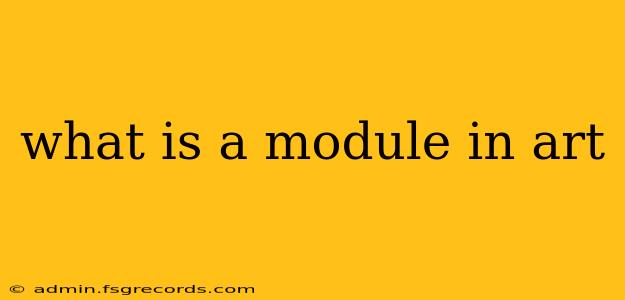The term "module" in art refers to a single, self-contained unit that is repeated and varied to create a larger, more complex composition. Think of it as a fundamental building block, like a LEGO brick, that artists use to construct their artwork. Understanding modules is key to appreciating the underlying structure and visual impact of many artworks, from ancient mosaics to contemporary installations.
The Core Concept of Modularity
At its heart, modularity relies on the principles of repetition and variation. The same module is repeated multiple times, but with subtle or significant changes in its form, color, orientation, or placement. This repetition creates a sense of rhythm and visual unity, while the variation introduces dynamism and prevents monotony. The interplay between these two principles is what gives modular art its distinctive character.
Repetition: Establishing Rhythm and Unity
The repetition of a module establishes a strong visual rhythm. The eye is drawn to the recurring patterns, creating a sense of order and predictability. This repetition acts as a unifying element, connecting different parts of the artwork and giving it a cohesive structure. The more frequently a module repeats, the stronger this sense of rhythm becomes.
Variation: Injecting Dynamism and Interest
While repetition provides structure, variation prevents the artwork from becoming static or boring. Variations can be subtle, such as a slight change in color or texture, or they can be more dramatic, involving a complete transformation of the module's form. This variation keeps the viewer engaged, encouraging them to explore the nuances and complexities of the artwork.
Examples of Modules in Art
Modularity is found across various art forms and historical periods:
1. Mosaics: Ancient and Enduring Modules
Ancient Roman and Byzantine mosaics provide a prime example of modular art. Small, colored tesserae (tiles) act as individual modules, repeated and arranged to create intricate patterns and images. The variation in color and shape of these tesserae contributes to the overall richness and detail of the mosaic.
2. Islamic Geometric Patterns: Precision and Repetition
Islamic art frequently utilizes modularity in its intricate geometric patterns. Simple geometric shapes, such as stars, polygons, and arabesques, serve as modules, repeated and interlocked to create complex, visually stunning designs. The precision and mathematical basis of these patterns highlight the importance of repetition and systematic variation.
3. Modern and Contemporary Art: Exploration of Modularity
In modern and contemporary art, modularity is explored in diverse ways. Artists like Josef Albers, with his "Homage to the Square" series, used simple square modules with subtle color variations to explore the perceptual effects of color interaction. Other artists use modularity to create large-scale installations, kinetic sculptures, or digital art, pushing the boundaries of the medium.
Understanding the Impact of Modularity
The use of modules in art offers several key advantages:
- Simplicity and Complexity: Modular art can appear simple at first glance, but upon closer inspection, reveals a sophisticated underlying structure and intricate variations.
- Scalability and Flexibility: Modules can be easily scaled up or down, allowing artists to create works of various sizes and proportions.
- Economic Efficiency: Repetition simplifies the production process, especially in mediums like mosaics or textiles.
- Visual Impact: The interplay between repetition and variation creates a strong visual impact, capturing the viewer's attention and stimulating their imagination.
In conclusion, understanding the concept of a module in art offers a deeper appreciation for the underlying structure and creative process behind numerous artworks. By analyzing the repetition and variation of modules, we can gain valuable insights into the artist's intentions and the overall impact of the artwork.

